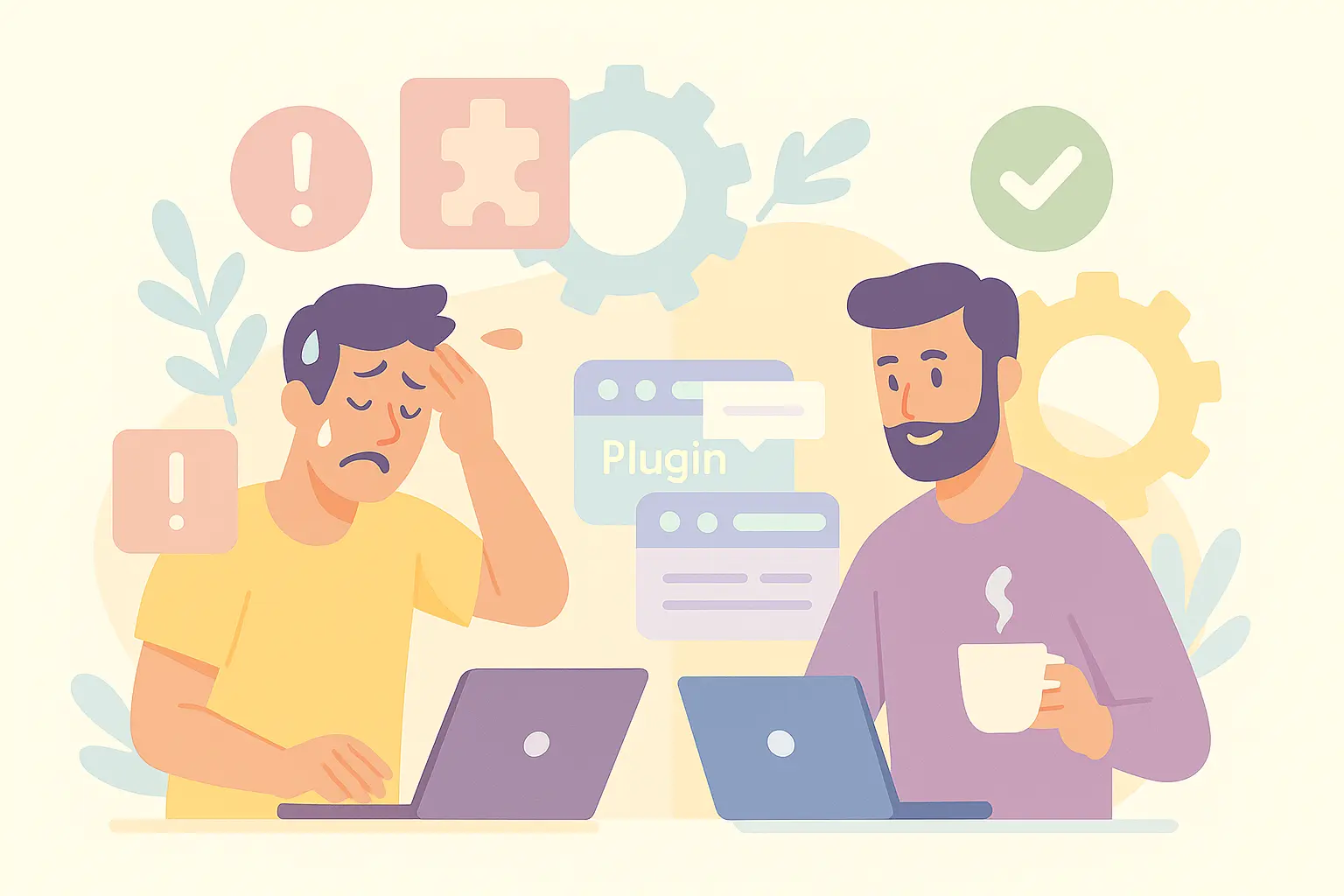The DIY Trap
We’ve all been there—tackling DIY website maintenance when you spot that plugin-update notification and think, “It’s just one click. Why should I hire someone to click a button for me?” But that single click can quickly turn costly, leading to broken forms, lost leads, or even a full site outage.
With a bit of Googling or ChatGPT assistance, DIY website maintenance can feel totally doable—and the money you save might go toward production costs or marketing ventures. What could possibly go wrong? Or, you could hire someone for around $200/month and let your website quietly hum along, delivering sales and leads—hassle-free.
What DIY Website Maintenance Really Looks Like
From our experience talking to clients, DIY website maintenance is the last thing on their minds. Sometimes it addressed in a best case scenerio, forgotten at worst. Common scenarios include:
Backup uncertainty: Not knowing if your website is backed up regularly, or at all. Updraft Plus is a free, widely used solution.
Plugin chaos: Updating plugins occasionally, only to find a critical function like your contact form broken. You might only discover it when leads dry up.
Layout glitches: Strange changes in your homepage layout that linger on your “to fix” list indefinitely.
Security blindspots: Believing your site is secure because of the padlock icon.
Neglected SEO: Overlooking SEO essentials because you’re busy updating products or pages.
Clients often describe a sinking feeling: “We’ve managed fine until now…what changed?” DIY maintenance seems cost-effective until it quietly becomes a drain on time, energy, and ultimately, revenue.
DIY Website Maintenance: Pros & Cons
| Pros | Cons |
|---|---|
| 💸 Low upfront cost | 🕒 Easy to neglect, time-consuming |
| 🧠 Full control over changes | ❌ Risk of breaking the site |
| 🔧 Learning new skills | 🔒 Security gaps often unnoticed |
| 📆 Flexible scheduling | 📉 SEO and performance often suffer unnoticed |
| 📚 Plenty of online tutorials | 🧠 Constant mental burden |
| ✅ Works fine—until it doesn’t | 🔄 No proactive support when issues arise |
What Professionals Bring to the Table
When you hire professionals (like Candor Studios), the first thing you’ll notice is relief from the mental load. Here’s how:
Communication: Clear, no-nonsense, no-jargon communication. Letting you know your site is working, pointing out road bumps before the come.
Backups: Ensuring your entire site and database are backed up consistently and reliably—not just a few random pages.
Security: Reviewing your hosting security (whether it’s SiteGround, Kinsta, VentraIP, or Hostinger). We also audit user access, removing old employee or agency logins—a simple but crucial security step.
Updates (WordPress, plugins, themes): Outdated software is the leading cause of security breaches. Updates address features, bug fixes, and vulnerabilities. We handle updates safely, reducing risk and immediately addressing odd layout changes.
All this (and more, depending on your package) happens proactively. This stops issues before they become costly problems.
The Real Cost of DIY: Time, Stress, Lost Revenue
Time is money, and DIY website maintenance often starts cheaply but becomes expensive quickly. Imagine this common scenario: You update your website, something breaks, and suddenly you’re calling your developer or hosting company. At around $120 per hour for ad-hoc website support in Newcastle, even a few hours spent explaining, troubleshooting, and fixing issues can blow past the cost of a professional maintenance package (around $180/month).
Hiring freelancers may seem cheaper initially, but factor in hours posting jobs, reviewing proposals, and supervising the work—and the savings evaporate. Neither scenario even considers lost leads and sales from unnoticed issues.
Signs It’s Time to Outsource
Even if DIY maintenance feels manageable, certain red flags show when it’s costing you more than you realise:
You’re constantly postponing updates. If checking backups or updating plugins always gets delayed, critical tasks aren’t being done.
You’re unsure what’s working. If you’re unclear about where leads come from or page-loading times, you’re flying blind.
You’ve had a scare or crash. Unexpected outages highlight just how vulnerable DIY maintenance can leave your site.
Tech feels overwhelming. Even when fixes are manageable via Google, they’re mentally draining and stressful.
You’re wasting growth time on fixes. Every hour spent fixing website issues is one hour less spent on marketing, strategy, or clients.
Your business has evolved. If your team or services have changed but your site hasn’t kept pace, maintenance is essential.
No clear website ownership. When original designers or team members leave, website responsibility becomes unclear, making outsourced care essential.
Spot any of these? It’s definitely time to hand off your website maintenance so you can focus on growing your business.
How to Choose Your Website Maintenance Partner
Finding the right maintenance partner means finding someone trustworthy, accountable, and accessible. Consider:
Do they listen first? A good provider listens carefully before recommending solutions.
Do they offer a site review first? Reputable providers examine your site before quoting, ensuring solutions fit your actual needs.
Are you locked into contracts? Flexible, month-to-month support allows you to scale your support level comfortably. At Candor Studios, no lock-ins mean just honest, ongoing support.
Are communications clear and jargon-free? You should always understand exactly what you’re paying for and receiving.
Can you easily contact them? Avoid faceless ticket systems. You should feel comfortable jumping on a quick Zoom or phone call whenever you have questions.
DIY or Outsource—Your Next Move
DIY website maintenance can initially seem smart but quickly becomes a hidden drain on your resources. Hiring a professional shifts website maintenance from a stressful “to-do” to seamless business growth.
If you’re still unsure, get a free, no-obligation Website Health Check from Candor Studios. In one short report, we’ll show you clearly what’s working, what’s not, and whether DIY or professional care will best serve your business.
Take the guesswork out of your website’s health, and free up your focus for what you do best: growing your business.

